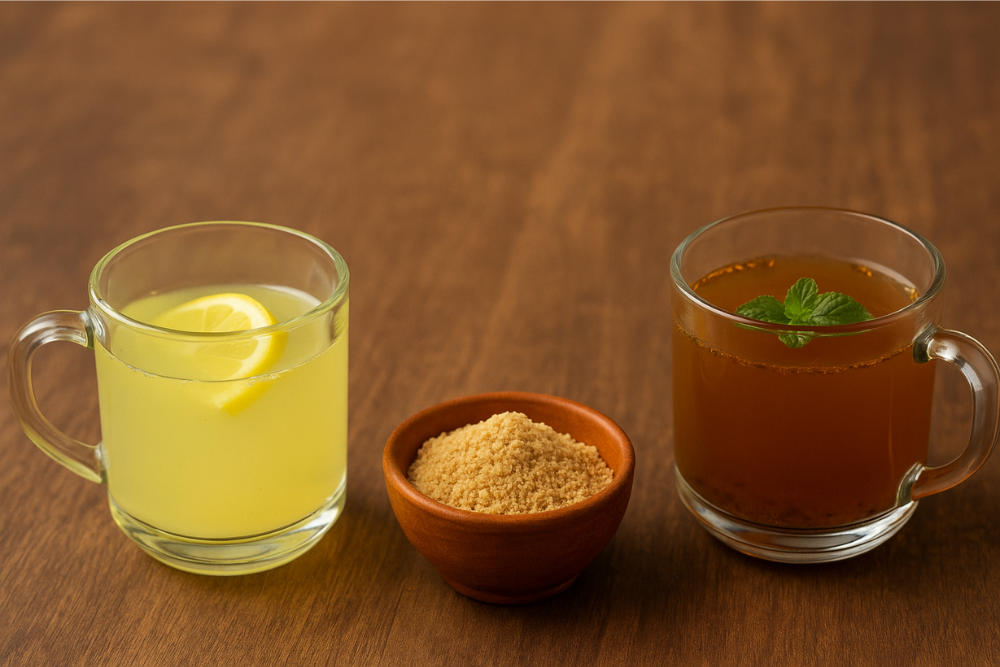Why is Hing Considered Ideal for Breaking a Fast — What Does Ayurveda Say About Its Benefits?
Short Answer: Ayurveda recommends Hing to break a fast as it stimulates agni (digestive fire), prevents gas, and restores digestive balance gently.
Long Answer:
- Stimulates Agni (Digestive Fire): After fasting, the body’s digestive strength (agni) is low. Hing helps reignite it smoothly without overwhelming the system.
- Prevents Bloating and Gas: Fasting often leads to vata imbalance, causing bloating or flatulence. Hing, with its vata-pacifying properties, prevents this.
- Reduces Ama (Toxins): According to Ayurveda, Hing assists in detoxifying the gut and reduces buildup of ama (digestive toxins).
- Balances Vata and Kapha: Fasting can disturb doshas. Hing balances vata and kapha, keeping digestion and immunity in sync post-fast.
- Improves Nutrient Absorption: Proper digestion ensures better absorption of nutrients after a fast. Hing helps enhance this process naturally.
How Should I Consume Hing After a Fast — Is There a Specific Recipe or Method?
Short Answer: Hing can be consumed as hing water, in light soups, or infused in ghee after fasting to support digestion and prevent discomfort.
Long Answer:
- Hing Water: Dissolve a pinch of hing in warm water and sip slowly. This is the simplest and most effective way to activate digestion.
- Hing-Infused Ghee: Add a pinch of hing to a teaspoon of melted ghee and consume it directly or add to plain rice or khichdi.
- Light Soups with Hing: Moong dal or vegetable soups with a tempering of hing in ghee can be soothing and easy to digest post-fast.
- Hing Tea: Boil water with cumin, fennel, and a pinch of hing for a digestive tea post-fast.
- Soft Khichdi with Hing: Cook moong dal and rice with turmeric and hing for a nourishing first meal after a long fast.
Will Hing Help Reduce Post-Fast Bloating or Acidity?
Short Answer: Yes, Hing helps relieve bloating and acidity after fasting by calming vata, improving enzyme activity, and relaxing the gut muscles.
Long Answer:
- Anti-Bloating Action: Hing acts as a natural carminative that relieves trapped gas and bloating effectively.
- Reduces Acidity: Its alkalizing nature helps neutralize excess stomach acid, preventing heartburn after a fast.
- Enhances Enzyme Secretion: Hing stimulates the release of digestive enzymes, aiding smooth transition to solid food.
- Relaxes Intestinal Muscles: It calms spasms in the digestive tract, which is common after fasting, easing discomfort.
- Supports Gut Health: By reducing inflammation, hing promotes a healthy gut microbiome and strengthens digestion long-term.
Can I Use Hing If I’m Doing Intermittent Fasting or a Fruit Fast — Is It Compatible?
Short Answer: Yes, Hing is compatible with intermittent fasting and fruit fasting, especially when breaking the fast with warm liquids or light meals.
Long Answer:
- Intermittent Fasting: After your fasting window, you can use hing in soups, teas, or ghee to help restart digestion gently.
- Fruit Fasting: Add hing to warm water or fruit soups to prevent bloating, which is common with excessive fruit intake.
- Supports Low-Calorie Transitions: Hing has negligible calories but high digestive impact, making it ideal post-fast.
- No Sugar Spike: Unlike some post-fast foods, hing does not cause a blood sugar spike, making it safe.
- Enhances Satiety: When taken with ghee or soup, hing can help you feel full and avoid overeating after a fast.
Are There Any Side Effects or Precautions When Using Hing After Fasting?
Short Answer: While hing is generally safe, excessive consumption or low-quality products may cause irritation. People with allergies or pregnancy should use caution.
Long Answer:
- Moderate Dosage: Use only a pinch (about 100–250 mg) after a fast. Overuse can irritate the stomach lining.
- Check Purity: Always use pure, food-grade hing. Many commercial products are mixed with wheat or additives.
- Avoid During Pregnancy: In large quantities, hing may stimulate uterine contractions. Consult your doctor before use if pregnant.
- Allergy Risks: Those allergic to asafoetida or with severe IBS should avoid hing or start with small doses.
- Storage Matters: Store in an airtight container. Moisture or exposure to air can degrade its quality and potency.
Comparison Table: Hing vs. Other Digestive Spices Post-Fasting
| Spice | Post-Fast Benefits | Agni Stimulation | Gas/Bloating Relief | Best Usage Form |
|---|---|---|---|---|
| Hing (Asafoetida) | Excellent for vata balance, gut detox | High | Excellent | Water, ghee, soup |
| Cumin | Improves digestion & reduces acidity | Moderate | Good | Tea, powder |
| Ginger | Warms and soothes the stomach | High | Moderate | Tea, grated fresh |
| Fennel | Soothes intestines post-fast | Low | Good | Chewed, tea |
Conclusion
Breaking a fast requires mindfulness — and hing to break a fast is one of Ayurveda’s best-kept secrets. From kindling agni and preventing bloating to easing you back into regular eating, hing is both gentle and powerful. Whether you fast intermittently, seasonally, or for detox, a pinch of hing can go a long way in supporting your digestive health. Just remember to use it in moderation, opt for high-quality hing, and tailor it to your body’s needs.





